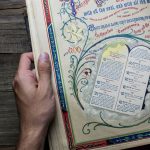I love bacon and ham and the occasional scallop. Sometimes, there’s nothing that will substitute for a grilled pork chop. Yet for thousands of years, God’s people were denied these delights. Why?
Many Christians immediately look for reasons of hygiene or health. Pigs wallow in muck, and pork breeds the larvae that cause trichinosis. Shrimp and lobsters are scavengers. God wisely kept Israel away from food that wouldn’t be good for them. The problem with that explanation is that, in the opinion of most Christians, God stopped prohibiting these meats in the new covenant. Is he less concerned with our health now?
To grasp the biblical logic behind the Torah’s rules about unclean food, we need to answer two questions. First, what are animals? Second, what is eating?
Neither question is as simple as it looks.
Creation’s Animals
God created many kinds of animals, but Genesis 1 groups them together in several large phyla. The Bible’s taxonomy of animals is different from ours: it emphasizes environment rather than reproduction. On days five and six, God creates living souls of the sea, of the sky, and of the earth (Gen. 1:20–25).
We learn later that “bats” are listed among “birds” (Lev. 11:19). Leviticus 11 treats amphibians, rodents, and reptiles as members of one large category of “creeping things.” Those details aren’t evidence of scientific ignorance. Scripture simply uses a different scientific scheme. For the Bible, “birds” are “flying things.” Since bats fly, they belong with other “flying things.” Mice and geckos both creep along the ground, so they’re lumped into the same group.
Land animals are further subdivided into “cattle and creeping things and beasts of the earth” (Gen. 1:25). Like the larger categories, these are environmentally based. “Cattle” (behemah) live near man, “beasts” (chayyah) are more distant, and most “creepers” (remes) are untamed animals that sneak into human environments (the mice in your attic, the moles tearing up your lawn).
Adam was told to rule over all the animals (Gen. 1:27–28). But some land animals are created domesticated, while others are to be tamed over time. Later visions of lions and lambs, wolves and cattle, lying together in peace don’t portray a “return to Eden” but an advance on Eden (Isa. 11:6–9). The prophets glimpse the trajectory of human dominion by envisioning a world where all creatures have become “cattle.”
Clean and Unclean Animals
By the time of Noah, animals had been subdivided yet again, into categories of “clean” and “unclean” (Gen. 7:2–3, 8–9). The distinction is at least a liturgical one, since after the flood Noah offers one of every kind of clean animal as an ascension offering (Gen. 8:20–21). He doesn’t offer any of the unclean ones.
The role of animals changes dramatically with the Mosaic covenant. Things get much more complicated. The rules of unclean food still follow the creation taxonomy. Leviticus 11 lists clean and unclean land animals (vv. 2–8), sea creatures (vv. 9–12), flying things including winged insects (vv. 13–23), and creeping things (vv. 29–30). Yet, because Yahweh draws near to dwell amid Israel, new restrictions come into play. Israelites can’t offer every clean animal on the altar, as Noah did. Under the Mosaic order, “clean” animals are subdivided into “sacrificial” and “non-sacrificial” classes. Some clean domestic animals or “cattle” (bovines, sheep, goats, turtledoves, pigeons) may be placed on the altar, but some domestic animals are unclean (donkeys, camels). No wild animals, creeping things, or fish are sacrificed, but some wild land animals are clean and may be eaten (deer, roebuck). Unclean wild animals, like unclean domestic animals, are forbidden food (rock badgers, rabbits, pigs).
There’s nothing new about animals. Pigs wallowed in mud and shrimps scavenged in the seabed long before Moses, but they weren’t explicitly prohibited. Deer were deer before the Mosaic covenant, but Noah could sacrifice deer and Moses couldn’t. The new thing is the condition of Israel, particularly in their relation to the rest of the nations.
Deer were deer before the Mosaic covenant, but Noah could sacrifice deer and Moses couldn’t. The new thing is the condition of Israel, particularly in their relation to the rest of the nations.
Animals represent human beings. The analogy is built into creation. Land animals are creatures of the sixth day, made from the ground, just like human beings (Gen. 1:24–28; 2:7). Both animals and human beings are blessed to multiply (Gen. 1:22). Humans and other living creatures are called “souls” (nephesh; 1:20–21, 24, 30; 2:7). Land animals and human beings feed on the same original diet of green plants (1:29–30).
Groupings of animals, thus, represent groupings of human beings. Sacrificial animals, which ascend to the altar to be turned to smoke, serve a priestly role in Israel’s worship, mediating between worshipers and Yahweh. They represent Israel, the priestly people, and especially the priests, who also mediate between Israel and the Lord. Clean but non-sacrificial animals represent Gentiles who worship Yahweh, Gentiles like Melchizedek or Jethro, Moses’s father-in-law. Unclean animals symbolize idolaters and enemies of Israel.
The general conduct of animals doesn’t determine whether they’re clean or unclean. Pigs aren’t unclean because they roll in mud and eat slop. The pig is unclean because “though it divides the hoof, thus making a split hoof, it does not chew cud” (Lev. 11:7). Land animals are clean or unclean depending on their “footwear” and their eating habits. Sea creatures are clean if they have fins and scales, unclean if they don’t (Lev. 11:9). That is, animals are clean or unclean depending on how they relate to their environment, whether to dust or water. Clean animals are the ones who are “armored” to protect them from the world around them.
If the serpent is a dust-eater, he’s a man-eater, an agent of the curse who drags Adam’s children down to the dust of death.
The curse on the serpent is in the background: “On your belly shall you go, and dust you shall eat all the days of your life” (Gen. 3:14). Man is made of dust and is cursed to return to dust (3:19). If the serpent is a dust-eater, he’s a man-eater, an agent of the curse who drags Adam’s children down to the dust of death. Land animals walk in the cursed dust are serpentine, and Israel is forbidden to eat them.
Eating as Identification
Why are they forbidden food? At a broad level, the food prohibitions of the old covenant show that Israel is still living in the old Adam. The “do not taste, do not touch” rules of the garden still apply. But the laws of unclean meats also assume a certain understanding of food and eating. Eating isn’t the same as fueling. Eating is incorporation. To eat is to become one body with what we eat and with our table companions. What we put into our bodies becomes one with us. Our table companions become members of a corporate body.
To eat is to become one body with what we eat and with our table companions. . . . [The Israelites] aren’t to incorporate unclean meat, so they’ll learn to avoid unclean people.
Israel is called to be a separate people. They exist to serve the Gentiles, to bring Yahweh’s blessing to the world, and to light the nations. But to be light, they need to avoid communion with darkness. They keep the food laws to maintain the God-given wall between Jews and Gentiles. Israel is prohibited from eating animals with serpentine features to train them to avoid communion at the table of demons. They aren’t to incorporate unclean meat, so they’ll learn to avoid unclean people.
Jesus died to break the dividing wall. The human race is no longer divided between Jew and Gentile, but now between the Seed of the woman and the seed of the serpent. The food restrictions that kept Israel separated from Gentiles are canceled. That’s the message to Peter in Acts 10–11: a sheet full of animals is lowered from heaven and Peter is invited to eat. He objects that he’s never eaten unclean meat, but is told to do so. The whole context, though, has to do with Peter’s reception of Cornelius. He can eat unclean food; he can commune as an equal with the Gentile Cornelius. These are two implications of the gospel. For us, nothing is to be rejected, if it’s received with gratitude (1 Tim. 4:4).
New Covenant Menu
Christians have been right to celebrate Christmas with ham, because Jesus brings an end to the division of Jews and Gentiles, and for that reason an end to the old covenant fast. All food is clean. Enjoy your rattlesnake burrito, your lobster bisque, your alligator steak. Eat crow or crayfish if you like. Enjoy them in Christ, because he put these foods on your menu.
Jesus brings an end to the division of Jews and Gentiles, and for that reason an end to the old covenant fast.
Jesus fulfills the law, but Torah is still God’s instruction to us. We can eat anything, but we’re still under food restrictions of a sort. The New Testament’s food laws don’t have to do with what we eat; they concern where we eat, and especially with whom. Paul commands us to avoid the table of demons. We aren’t to have communion with the works of darkness, nor to share bread (com-pany = cum-panis = with-bread) at the table of the wicked. This is what Israel’s food laws always aimed at. They ritualized a perpetual Pauline warning: “Bad company corrupts good morals” (1 Cor. 15:33).
Is there enough evidence for us to believe the Gospels?
 In an age of faith deconstruction and skepticism about the Bible’s authority, it’s common to hear claims that the Gospels are unreliable propaganda. And if the Gospels are shown to be historically unreliable, the whole foundation of Christianity begins to crumble.
In an age of faith deconstruction and skepticism about the Bible’s authority, it’s common to hear claims that the Gospels are unreliable propaganda. And if the Gospels are shown to be historically unreliable, the whole foundation of Christianity begins to crumble.



































